The Divestiture of ATT and the Telecommunications Act of 199
The Divestiture of AT&T and the Telecommunications Act of 1996 had a major impact in the United States. The Divestiture of the Bell Operating Companies from AT&T was one of the critical events of the 1980s that continues in importance today.
Give a brief description of the rationale for divestiture, how it relates to the AT&T Consent Decree and other legal actions, and recent consolidation in the industry.
Build a matrix of three pro and three con arguments concerning the break-up of AT&T.
Describe the impact of the Telecom Act of 1996 on
local phone service
cable TV
long-distance phone rates
Discuss the impact of the Telecom Act on:
Mergers and partnerships
Services
Competition
Layer One:
Describe how data is transmitted using Amplitude Modulation
Describe how data is transmitted using Frequency Modulation
Describe environments that you would recommend for the following type of Layer One media, and why that specific type is preferred:
Wireless WAN
Wireless LAN
CAT5 or CAT6 cable
Single-mode Fiber-optic Cable
Multi-mode Fiber-optic cable.
There are several types of Multiplexing.
What distinguishes Frequency Division Multiplexing
What distinguishes Time Division Multiplexing
What distinguishes Wave Division Multiplexing
If you were buying a multiplexer, why would you choose either a FDM or TDM?
Layer Two: controls access and handles errors.
Describe three access control methodologies.
Describe the techniques in Layer 2 that Prevent errors.
Describe the methods in Layer 2 that Control errors.
Describe three Layer 2 Error Detection methods
Draw how a series of FOUR separate messages would be successfully sent from one computer to another using ARQ if:
the first message was transmitted without error
the second message was initially transmitted with an error
the third message was initially lost
and the ACK for the fourth message was initially lost.
Use Visio or PowerPoint format
You have downloaded a number of Word and PowerPoint files from D2L. Assuming that the next file you will download is 3.4Mb, how long would it take using the following circuits? Also assume that control characters and management overhead adds a total of an extra 10% to the message.
Dialup modem at 33.6 Kbps
Cable modem at 384 Kbps
T-1 line at 1.5 Mbps
Show your work using a spreadsheet and graph the results using a bar graph format.
Create a table for the OSI protocol stack listing:
Layer Number
Layer Name
Layer Functions in detail
Layer Sample Protocol(s)
Layer Name for its “chunk of data” if applicable
Solution
seeking different ways of doing this since the beginning of time. The methods used have been as varied as the users. Runners, distant drums, smoke signals, carrier pigeons, the Pony Express and the telegraph are just a few of the many early methods man has used.
It was not until the late nineteenth century, however, that man was able to send and retrieve information by less physically limiting ways. The telegraph, radio, and telephone had been invented, which enabled people to communicate at a large distance almost instantly.
As the year 2000 approaches, the telecommunications industry is literally changing day by day. To better understand today\'s environment, we need to look first at the past. Historical events, regulation and laws, consumer needs, and technological advances have all intertwined to influence changes in the industry.
the very beginning, the government sought to regulate the industry by enforcing standards and limiting competition. In this era, AT&T dominated as the telephone monopoly.
The Interstate Commerce Act of 1887 established the Interstate Commerce Commission (ICC) to regulate companies that carried goods and people between states, of which the railroads were the first.
Although the early regulation of carriers were those that carried goods and people, subsequent legislation determined that communications were also being \"carried\" interstate
When the telephone was invented, all calls were point-to-point connections. That meant that if you needed telephone service to five places, you would need five telephones in your location and each one would be directly connected to a telephone in the distant location. As the number of people with phones grew, this became a nightmare.
Point-to-point connections were not practical with large numbers of phones, so calls were soon connected to a \"central\" point where an operator would manually complete the connection to the distant point. The building where the operator made the connections became known as a Central Office.
The First Automatic Switching System
As the number of people with phones continued to grow, so did the demand on manually operated central offices.
In 1889, a Kansas City undertaker named A. B. Strowger was convinced that the operators were connecting calls that should have gone to him to a competing undertaker. So he invented the first automatic switching system that allowed callers to call him directly. This switch become the forerunner to the switches of today.
The Communications Act of 1934 established telecommunications as a regulated industry under the jurisdiction of the FCC.
The mission of the FCC is to encourage competition in all communications markets and to protect the public interest. In response to direction from Congress, the FCC develops and implements policy concerning interstate and international communications by radio, television, wire, satellite, and cable.
Areas of responsibility include:
The main objective of the Communications Act of 1934 was to create affordable and universal telephone service for the American people. As a result, AT&T was positioned to monopolize the industry.
AT&T had grown very quickly and formed the most far-reaching telephone network. Numerous new carriers entering the market with their own standards threatened to throw the industry into complete chaos. The need to decide on a telecommunications standard and the established presence of AT&T influenced the government\'s decision to make AT&T the telephone monopoly.
This set a precedence for deregulation since it allowed a direct electrical attachment of equipment to the network as long as it did not adversely affect it.
MCI (Microwave Communications Inc.) was originally a trucking firm whose operators used microwave radios to communicate to one another. MCI sued for the right to provide private telephone service and in 1969, it was allowed to operate between Chicago and St. Louis over a microwave network. This landmark decision opened the door to competition in the long distance market.
In the Specialized Common Carrier decision, also in 1969 in, the FCC decreed that the new microwave companies could compete with existing telephone companies in the sale of private network transmission services.
The use of telephone numbers was introduced in 1879. Early numbers were designated by the name of the Central Office and the 4-digit line number as in \"Beacon Hill 2478.\" The name of the Central Office was often based on its location or the name of a person of local significance.
As the use of dial phones became more prevalent, and the need for more numbers increased, the number plan changed to 3 letters and 4 numbers identifying the individual line, as in BEH-2478. By the 1930s the plan changed again to 2 letters and 5 numbers as in BE5-2478. But soon all the easy to remember codes were used.
By the 1950s, numbers replaced letters to create the All Number Calling Plan (ANC). By 1966, 75% of the U.S. used the ANC.
Calls to telephones not served by the originating Central Office are often connected by a trunk circuit to another nearby Central Office, which is known as an End Office (EO).
While the local loop or \"line\" is usually dedicated to one user, trunks are shared by many users and usually connect multi-user telecom facilities.
Lines:
A line is a communications circuit between a switching system and a customer\'s equipment. Residential service is provided over a line, typically a copper two-wire twisted pair (called a local loop) connected to a CO.
Residential access is also referred to as POTS (Plain Old Telephone Service). This refers to a basic switched access line with no special features or packages.
Trunks:
A trunk is a communications circuit between two switching systems. A trunks can carry a larger volume of calls simultaneously. Long distance traffic is routed from the local CO to the long-distance carriers through trunks. Trunks also connect local COs to each other.
As the network grew, more and more switches could not be directly connected with each other, so the need for higher level central switching centers arose. These became known as toll centers, primary centers, sectional centers, and regional centers.
The network formed a hierarchy with 12 regional centers serving the U.S. and Canada. All 12 of the regional centers were directly connected to each other. There were approximately 100 sectional centers, 300 primary centers, over 1000 toll centers, and more than 20,000 Central Offices.
Trunks connecting different levels and locations of switches formed alternate routes for call traffic. This network provided both local and long distance calling for the country.
With the increase in carriers after divestiture, there was a need to further define who carried, billed, and earned revenue from different types of calls. Since state boundaries and LATA boundaries do not always coincide, different types of calls are identified by jurisdiction.
The four jurisdictional combinations shown are:
Prior to divestiture, access to the network was not a concern. All phones had access to AT&T Long Lines for long distance and the switches in the network made the connection and recorded the necessary billing information.
The alternative long distance carriers had to rely on the Bell System to provide access. That early access required the originating caller to dial:
The difficulty of dialing up to 31 digits to make a long distance call plus the associated billing problems led to a decree that the LECs had to provide the same access from their switches to all long distance carriers that they provided to AT&T. This is also known as dialing parity.
The \"gateway\" where the call is handed off from the LEC\'s network to the Independent Carrier\'s (IC) network is called the Point of Presence (POP) or Access Customer Terminal Location (ACTL). Each IC providing service to customers in a LATA will have its own POP, and the LEC must route originating long distance calls to the appropriate POP.
The \"communications revolution\" has created the requirement to be quick and innovative, in business as well as technology.
This is in great part why Congress created, and president Clinton signed into law one of the most sweeping re-writes of the U.S. communications industry. The Telecommunications Act of 1996 dramatically altered the competitive and regulatory landscape for telecommunications companies, TV and radio broadcasters, cable system operators, and the Internet.
The purpose of the act is \"to provide for a pro-competitive, de-regulatory national policy framework designed to accelerate rapidly private sector deployment of advanced telecommunications and information technologies and services to all Americans by opening all telecommunication markets to competition.\"
With this act, the era of open competition in telecommunication has begun.
One of the biggest impacts of the act was to open the local phone market to competition and to open the long distance telephone industry to the RBOCs. In fact, the act preempts all state rules that restrict entry into or limit competition in telephone service, both local and long distance.
It also repeals the AT&T antitrust consent decree that prohibited the RBOCs from entering the long distance market, and opens the local market to competition by requiring all telecommunications providers to provide equal access and interconnection to their facilities and equipment by all other telecommunications carriers.
Under the act, local exchange carriers must comply with a checklist of 14 points, among which are the following:
The act increases competition in the long distance communications services industry by allowing the RBOCs entry once they meet certain competitive requirements in their own markets.
| The Communications Act of 1934 established telecommunications as a regulated industry under the jurisdiction of the FCC. The mission of the FCC is to encourage competition in all communications markets and to protect the public interest. In response to direction from Congress, the FCC develops and implements policy concerning interstate and international communications by radio, television, wire, satellite, and cable. Areas of responsibility include:
The main objective of the Communications Act of 1934 was to create affordable and universal telephone service for the American people. As a result, AT&T was positioned to monopolize the industry. AT&T had grown very quickly and formed the most far-reaching telephone network. Numerous new carriers entering the market with their own standards threatened to throw the industry into complete chaos. The need to decide on a telecommunications standard and the established presence of AT&T influenced the government\'s decision to make AT&T the telephone monopoly. |
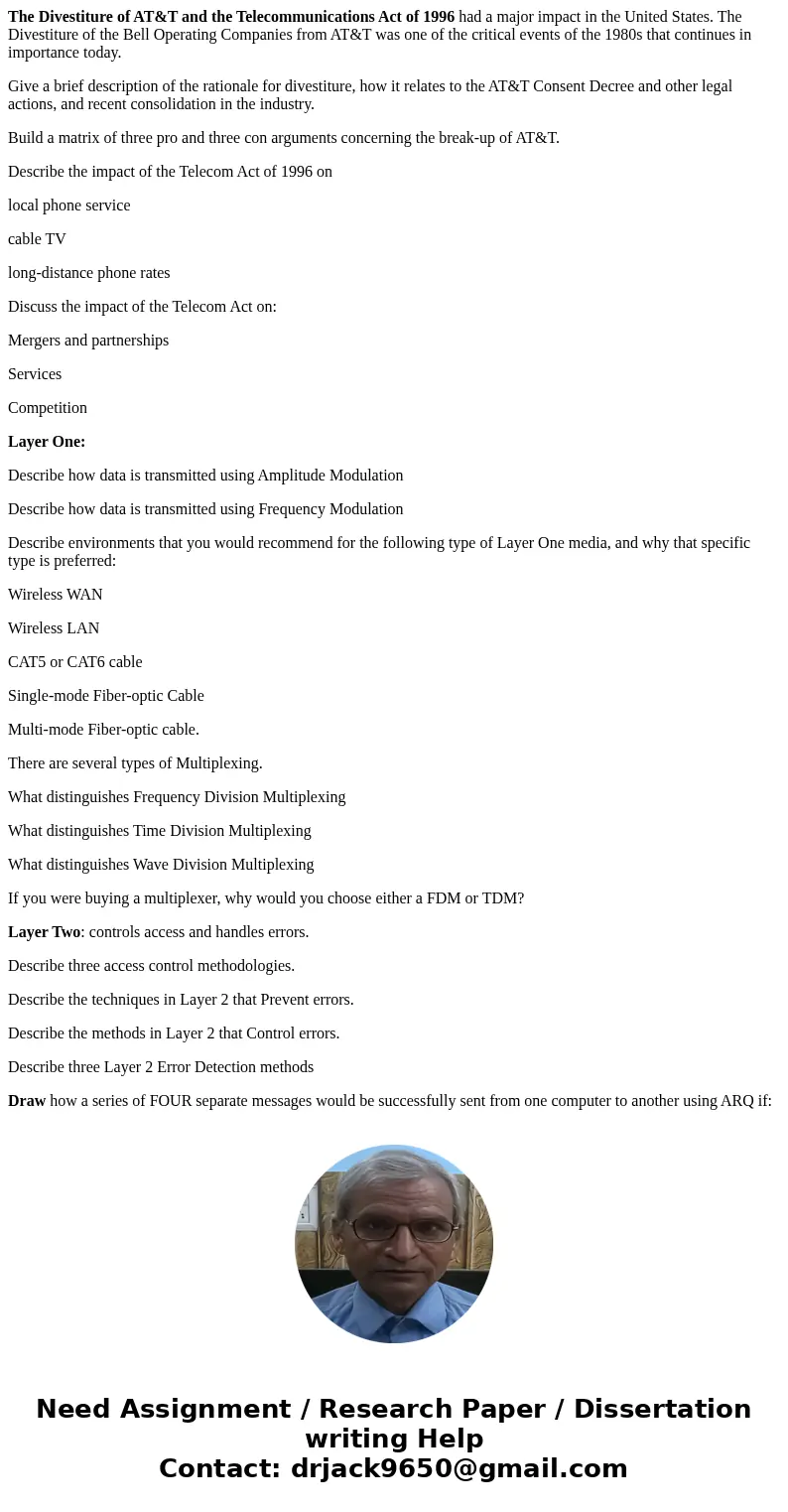
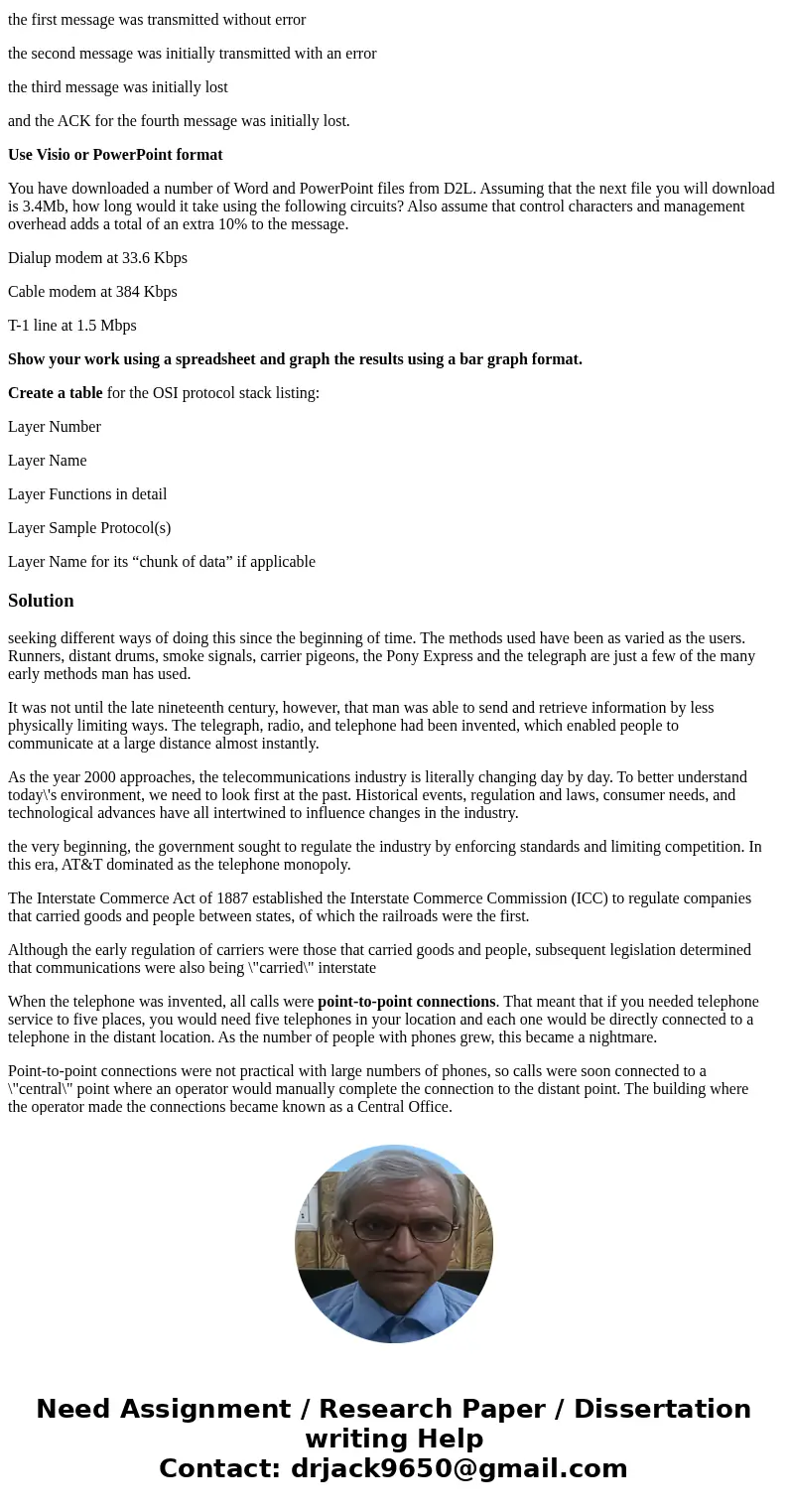
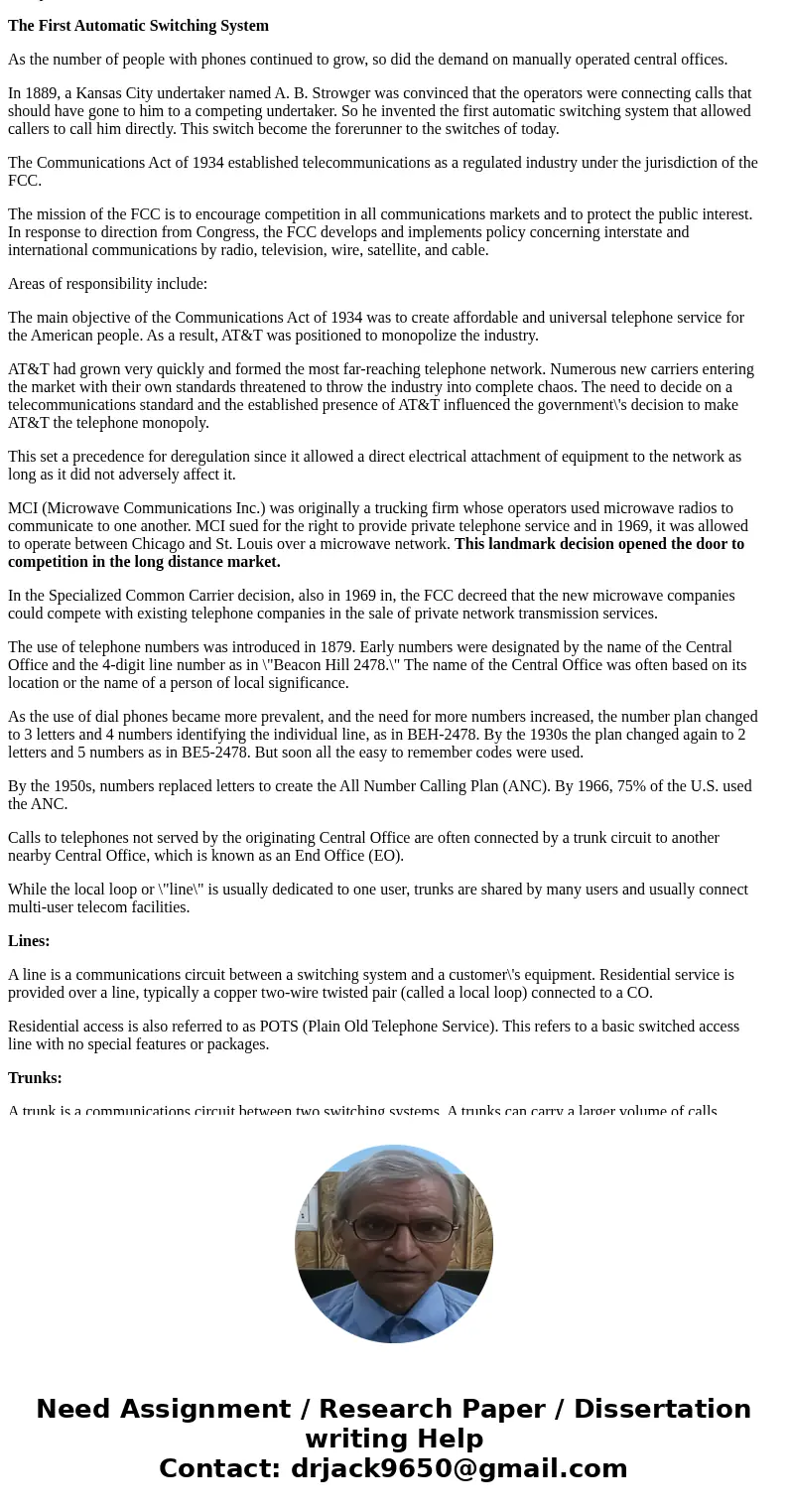
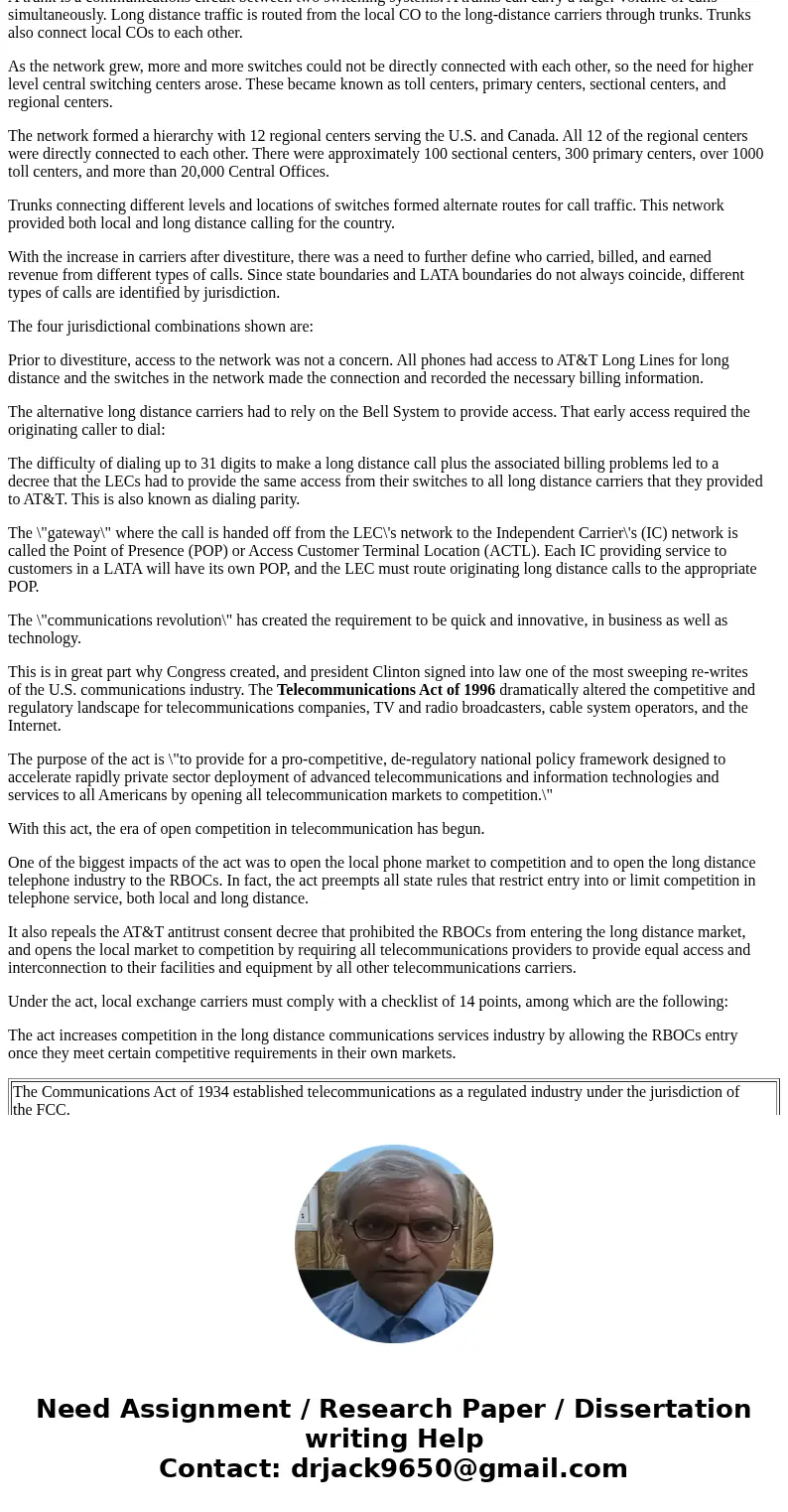
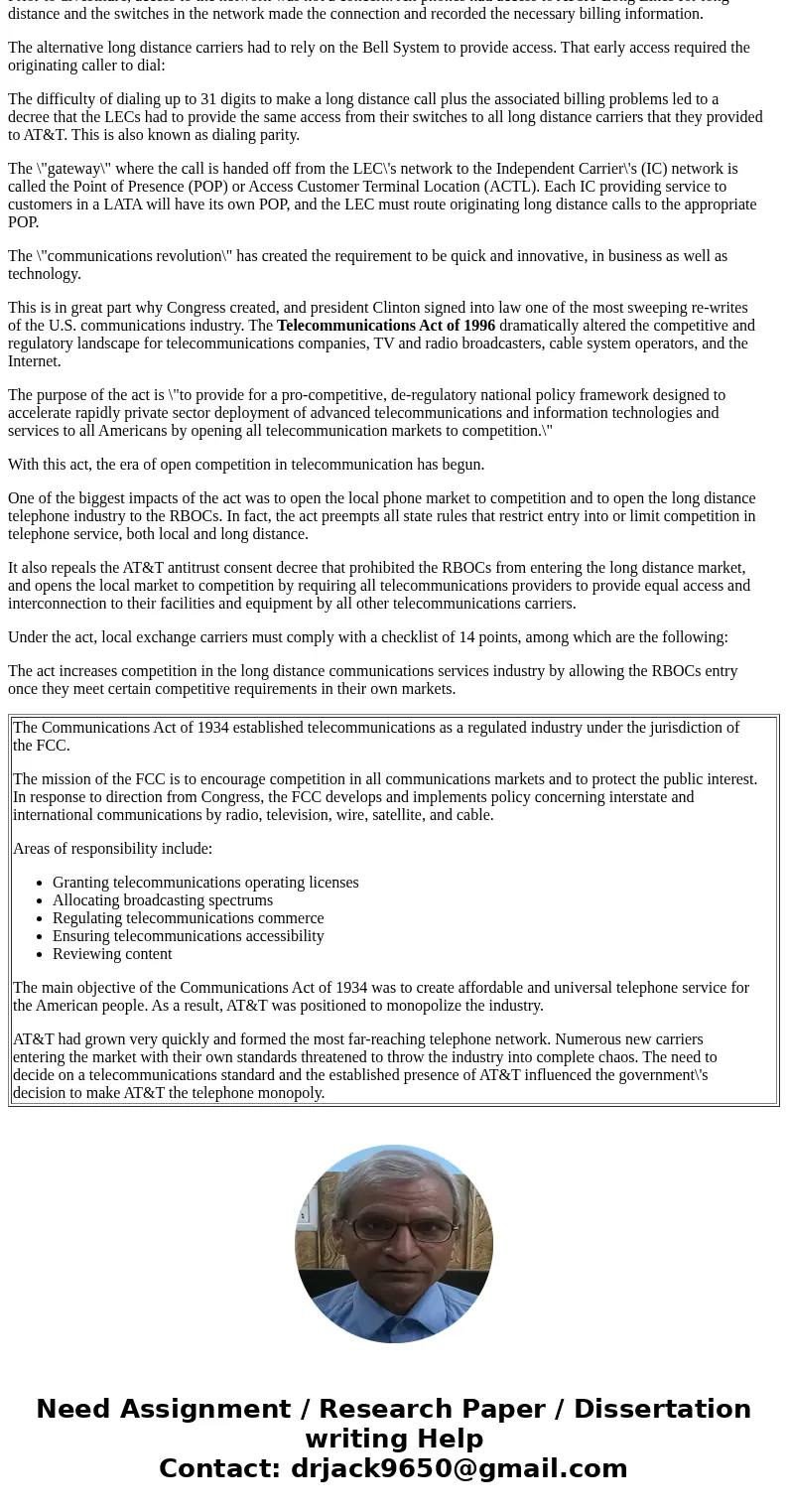
 Homework Sourse
Homework Sourse